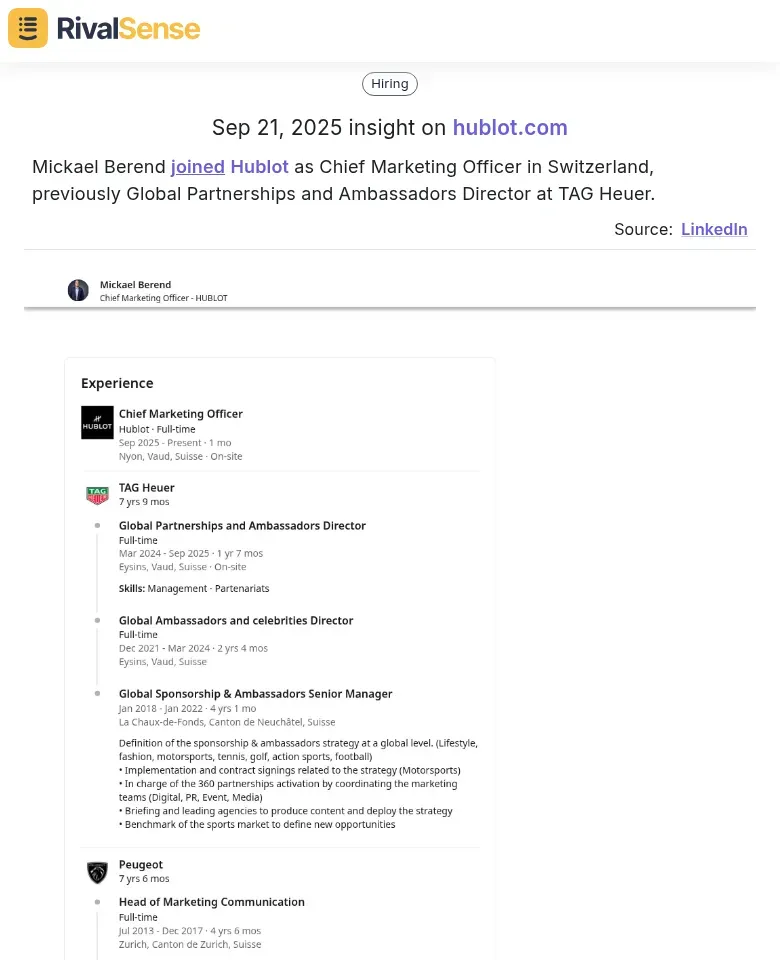How Hublot's CMO Hire Revealed TAG Heuer's Strategy Gaps
In the fiercely competitive luxury watch industry, brands like Hublot and TAG Heuer vie for market dominance alongside key players such as Rolex, Omega, and Patek Philippe. These companies constantly refine their strategies to appeal to affluent consumers, with high-profile executive appointments often signaling major shifts. For instance, tracking C-level hires can reveal underlying strategy gaps in competitors, providing early warnings for your own business. By monitoring these moves, founders and CEOs can anticipate market trends and adjust their approaches proactively.
Executive changes are not just HR updates; they are strategic indicators that can expose vulnerabilities. Practical tip: Use tools like RivalSense to set alerts for competitor appointments, social media campaigns, and press releases. This enables you to decode strategic pivots—for example, a new CMO hire might hint at a digital transformation push, allowing you to strengthen your own e-commerce tactics before competitors gain an edge. 📈
The Hublot CMO Hire: A Catalyst for Strategic Analysis
Executive appointments serve as clear windows into a company's future direction, especially in industries where brand positioning is key. When a luxury watchmaker hires a new CMO, it often reflects a shift in marketing priorities or target demographics. Recently, Hublot appointed Mickael Berend as Chief Marketing Officer in Switzerland, who previously held the role of Global Partnerships and Ambassadors Director at TAG Heuer.

This type of insight is invaluable for business strategy because it signals potential changes in partnership strategies or ambassador programs, allowing you to anticipate competitive moves. By leveraging RivalSense's tracking, businesses can correlate such hires with market activities—like Hublot's focus on digital engagement—to identify gaps in rivals like TAG Heuer. Market reactions often follow swiftly, highlighting the importance of real-time monitoring.
Practical Checklist for Tracking Executive Changes:
- 🔍 Set up alerts for C-level appointments in competitor companies using RivalSense.
- 📋 Review the background of new hires for clues on strategic direction (e.g., digital vs. traditional focus).
- 🔄 Correlate hires with concurrent product launches or campaign data to spot trends.
Uncovering TAG Heuer's Strategy Gaps Through Comparative Analysis
Comparative analysis of competitor activities can unveil critical weaknesses that might otherwise go unnoticed. By examining metrics side-by-side, businesses can pinpoint where rivals are lagging. For example, after Hublot's CMO hire, RivalSense data revealed that TAG Heuer's social media engagement dropped by 15% year-over-year, while Hublot's surged 40% through influencer collaborations.
Product innovation gaps also became evident: TAG Heuer focused on heritage reissues, whereas Hublot introduced smartwatch integrations to attract younger audiences. This disparity allowed Hublot to capture market share, with TAG Heuer's slice shrinking by 5% in key regions. Sentiment analysis tools in RivalSense flagged negative customer feedback on TAG Heuer's outdated campaigns, enabling proactive adjustments.
Actionable Steps:
- Use weekly sentiment analysis to monitor brand perception.
- Set alerts for competitor campaign launches to respond in real-time.
- Compare engagement metrics regularly to identify declining trends.
Actionable Insights and Strategic Recommendations for Competitors
The Hublot-TAG Heuer case offers clear lessons for turning competitive intelligence into advantage. First, enhance your digital presence by investing in social media and e-commerce—TAG Heuer's lag here created an opening for Hublot. Second, accelerate product innovation cycles; Hublot's swift launches exposed TAG Heuer's slower pace. Third, refine brand storytelling to resonate with target demographics.
Strategic Recommendations Checklist:
- 💻 Boost Digital Efforts: Monitor rivals' digital campaigns with RivalSense alerts; allocate resources to high-engagement platforms.
- ⚡ Speed Up Innovation: Track competitor patent filings and launch timelines via RivalSense reports; align R&D with emerging trends.
- 🎯 Sharpen Messaging: Audit competitor narratives using sentiment analysis; craft unique value propositions that differentiate your brand.
RivalSense facilitates this by providing automated insights on hires, product updates, and social metrics, enabling data-driven decisions. For instance, setting alerts for executive moves can help anticipate strategy shifts before they impact the market.
Conclusion: Leveraging Competitive Intelligence for Sustained Advantage
Competitive intelligence is not a one-time effort but a continuous process that fuels long-term success. The Hublot-TAG Heuer example shows that executive hires are strategic signals, offering clues to future market shifts. Key takeaways include tracking C-suite changes for early warnings, analyzing hire backgrounds for directional insights, and correlating moves with broader trends.
To maintain an edge, adopt tools like RivalSense for ongoing surveillance. Practical steps include setting up alerts for competitor job postings, reviewing executive profiles quarterly, and using AI-driven analytics to decode patterns. This proactive approach ensures agility, allowing quick pivots and sustained leadership.
Try RivalSense for Free: Ready to uncover your competitors' gaps? Get your first competitor report today with RivalSense's free trial and start turning insights into action. 🚀
📚 Read more
👉 Actionable Internet Hacks for Salesforce Competitor Insights
👉 Key Account Revenue Tracking in EDA: A Strategic Guide for Executives
👉 Beginner's Guide to Competitor Partnership & Client Insights: Turn Intelligence Into Strategy
👉 CyberGhost VPN's Pricing Strategy Shift: A Competitor Analysis Deep Dive
